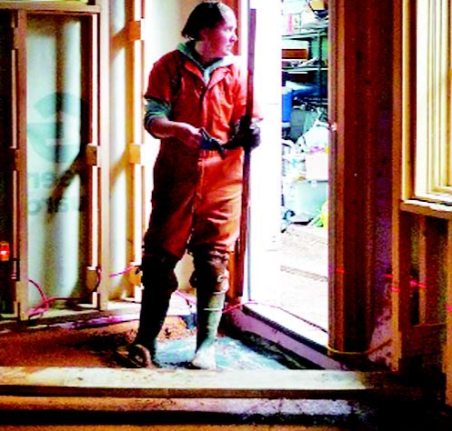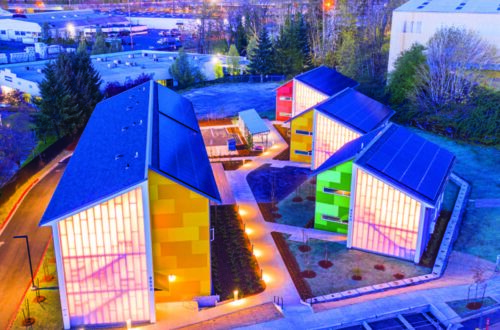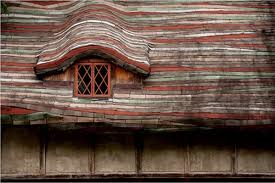Earthen floors are ancient. They were the predominant floor from the time people first built homes until the mid 1300s, and are still found today in many parts of the world. Because these early floors were simply tamped earth without sealers, they were dusty and cracks were common. As a result, they were often covered with mats. Native peoples in the Southwestern U.S. used blood to seal floors, and some of these floors are still in use today.
The Industrial Revolution brought with it many inexpensive flooring options and the earthen floor fell out of favor. Today they are experiencing a renaissance as more people become interested in natural and low impact building techniques.
Earthen floors are made of sand from the local rivers or rock crushing operations, local clay soils from construction digs, pond making or other holes, and organic fibers such as wheat straw or hemp. The finish coat can be left the color of the clay soil or colored with pigments.
The materials are mixed with water into a wet oatmeal consistency and transported to the floor location, usually by wheelbarrow. The pile of mud can then be raked out, and then it’s time to get down on your hands and knees to level with a hand tool called a float, and some sort of level tool to confirm.
Once an area is level and smoothed with a float, a steel trowel is used to bring the cream to the surface and left to dry. A day or so later, the floor can be pressed again, using floor pans or pieces of foam to get your body out on the leather hard floor. This will compress the materials into a denser floor, and again, bring some cream to the surface to create a smoother finish.
The wet floor can take up to 14 days to dry, but using fans and dehumidifiers can help to shorten drying time to a week. The dried floor is then sealed with coats of drying oils (linseed oil, tung oil) and natural thinners (citrus, turpentine). The finish coat will have beeswax dissolved in the oils for increased durability, ease of cleaning, and shine. About two weeks after the oils have been applied, the floor can be swept and mopped.
Not all oils are of the drying type, so it is imperative that the correct oil be used. Some examples are: linseed, tung, poppy, perilla, and walnut oil. These oils harden through a chemical reaction with oxygen in which components crosslink, creating flexible polymer chains. Traditional linoleum is made of linseed oil.
Earthen floors are harder than fir wood flooring, but not quite as hard as an oak floor. They have excellent thermal mass properties and work wonderfully with radiant heating systems and passive solar design. The materials require simple processing and little transport.
Even when mixed by machine, a finished earthen slab is estimated to have 90% lower embodied energy than finished concrete. (Adapted from Adobe and Rammed Earth Buildings, 1984)
Here are two installation tips to keep in mind:
1) Test your mix in an area of at least 2’ by 2’ by one inch thick. Make a few to find the right one. A good starting sample is 2 parts (mason) sand, 1 part your soil and 1/4 part straw. Some soils have a high clay content (60% or more) and some have a low clay content (15%). If the first sample is dusty it likely needs more clay, if the sample cracks it likely needs more sand. The floor is mostly a diverse size range of sand particles, stuck together with clay and woven with fiber for tensile strength and beauty.
2) Irregular drying can result in the floor cracking.
- Keep all batches of floor mix similar wetness.
- Cover windows and skylights that allow sun spots on the floor while it is drying.
- Pour whole rooms in one day to avoid cold joints.
- If screeding to level the floor, do not leave screed rails in the wet mud more than 30 minutes, and re-work the sides of the void before filling in.
- Consider control joints at door thresholds, where the shape of a floor comes in like an hourglass shape and around any posts or walls within the field of the floor.
- When pouring on framed subfloor, make sure the de- flection is very little (similar to preparing for tile). Add supportive framing to stiffen up a bouncy floor.
- We have learned that cracks can often be filled and smoothed before oiling. Should they appear later from building settling, you can fill them with oiled mud putty and continue to use the floor.
Sukita Reay Crimmel has been studying earthen floors specifically since 2006 with her construction company, From These Hands. She has recently developed “Claylin” a do-it-yourself, ready- mix earthen floor product. Sukita is currently working on a how to, technical earthen manual, due out Spring 2014.
For more info: www.sukita.com or www.claylin.com






8 Comments
John Atkinson
I want to do a whole house (new build) earthen floors. about 900 sq ft. besides being almost 70, I’m all alone in building it, wife is too weak to help. So can I use a cement mixer machine to mix clay, sand , straw etc. or must it be done by hand and foot. I also want to experiment with crushing sea shells in mix to give it a small shine on plaster walls. Will that work. thank you John
Susan Place
Hi John, I would suggest contacting the author of the article for a consult. https://www.claylin.com/contact/contact-us.php
Claire Bergeron
I put an earth floor in my home when we built it several years ago. It is very beautiful and dark, but now I am trying to bring more light into the house. What might be a way to lighten up the color? Any ideas. I was thinking of adding another coat of oil with something mixed in lime perhaps?
Susan Place
Hi Claire, You can get ahold of Sukita the author with her email link in her web site. http://www.sukita.com She may have a suggestion for you about color.
Robert
SO how does an earthen floor handle pets, such as an 80 lb dog and its claws. How is it against moving furniture. Does your feet get oily or dirty ever? For more durability could i follow this method and then use compressed tiles/blocks on the top layer? Would that make a harder top layer but still keep some of the sponginess?
Susan Place
These are great questions. I have never heard of any problems with an Earthen Floor. Please email Sukita the author of this article for more information. fromthesehands@sukita.com
Chris Przybyl
Blood is used in the mix in parts of Africa as well. The article doesn’t mention that earthen floors can be polished and buffed to look like the fanciest, most high-end textured and dyed concrete floor – but BETTER, and is noticeably softer (like wood) and easier on the joints and barefeet. It also is perhaps the easiest type of floor to repair.
Andrew
great article! It’s really something, the ways we have come full circle in so many applications of construction…